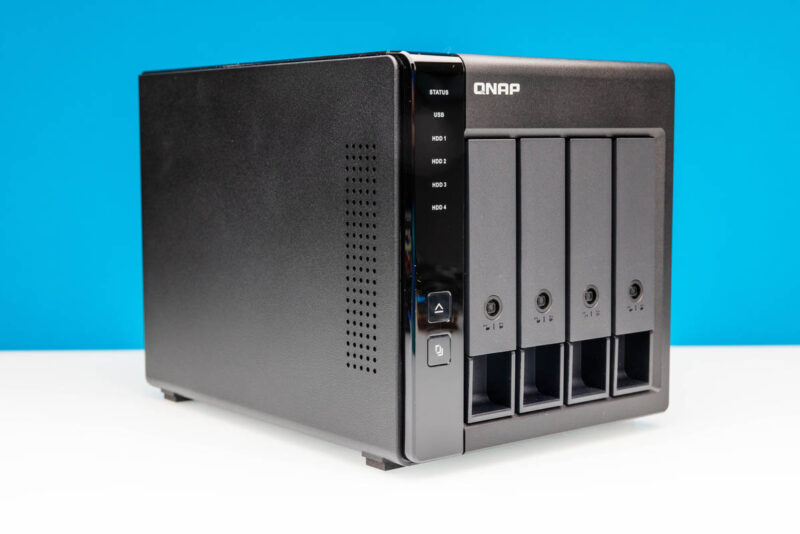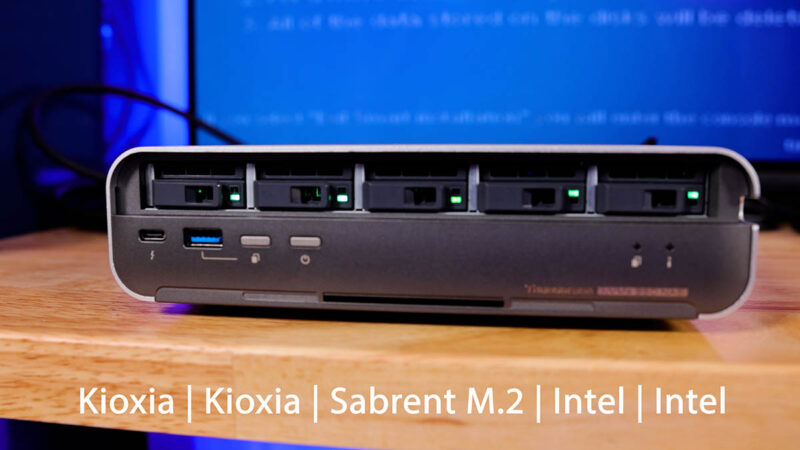Extending the NAS Using USB Enclosures
We showed this in the video, but we tried using the QNAP TR-004 USB RAID enclosure with the NAS.

When we did so, QNAP’s management recognized the enclosure and the drives without issue. It asked how we wanted to use the enclosure as storage expansion, backup, or to copy files off of.

Another cool feature was that by staying within the QNAP ecosystem, we got things like enclosure management so QuTS hero showed us which drives were installed, SMART data from the hard drives, and so forth.

For those who like this NAS, but are worried about the capacity, this can be an option. We also tested the TR-004 and TR-002 both connected to the NAS so there are other options as well.
Something Funky with Drives
Here is something we found that was not great. We noticed that when we installed different types of drives into the NAS, they could have different LED indicators. For example, here are Kioxia XD6 E1.S SSDs, a Sabrent 8TB M.2 SSD, and then two Intel P4511 E1.S SSDs running.

You can see the drives have different LED status orientations with the Intel P4511 drives being the ones flipped from the others. That was consistent across different drives.
QNAP TBS-h574TX Performance
In terms of performance. Intel Core i3-1320PE is faster than most high-end 1PB enterprise array CPUs from 10-15 years ago, so it has plenty of performance for a 5-bay NAS. One of the challenges with the solution, however, is that the drives are connected via PCIe Gen3 x2. As a result, if you have a 5-drive array (this almost feels like it is intended for RAID-Z / RAID 5 arrays) the performance over the 10GbE and 2.5GbE interfaces is not a challenge.

On the other hand, if you have a single drive, or use very low-quality consumer QLC SSDs, you will be bottlenecked by the performance of the SSDs running out of cache performance instead of the network interfaces or CPUs.
A primary use case is also going to be hooking up a video editing workstation to the NAS. Here is an example of BlackMagic Design’s Disk Speed Test that shows we have enough performance for even 12K ProRes 422 at 24fps with this NAS.

If you are wondering, if there is some variation to this test, the answer is yes. At the same time, we had managed to grab this screenshot at 1337MB/s read speeds so that felt like the day was done.
Next, we are going to get to power consumption, noise, and something strange we found.



$1200 is too much to ask for only 5 bays and 12gb of fixed ram. Pass.
WHAT A SCAM !!!
It is not a 4P8E processor, it is a 4P 4E core processor.
Power and Copy buttons right next to each other?
There are some errors. The i3-1320PE has 4P and 4E-cores and the i5-1340PE has 4 P and 8 E-cores. Please check your numbers.
Reivew
No ARM lower power higher performance chip, certainly no competition to Apple M series. I rather build my own nas with a bit more space and almost silent high quality fans. This qnap is terribly overpriced in 2024!
Better cheaper DAS/NAS could be Dell OptiPlex 5070 often $200. It has one internal m.2 and two PCIe slots. One with 4xM.2 board for $35 and another with 40Gb ConnectX-4 for $30. Total cost under $300. Probably could add couple of 2.5 ssd for additional storage.
40Gb is same as TB4 speed
@Karpo that is a.solid idea, I’d go for the 5080, the i5-10500 6c/12t and you can install crazy amounts of RAM (128GB), or even the Precision 3460, as I think that may come with Thunderbolt..
@Karpo. I am a photographer that has just arrived at the point of needing a DAS/NAS of some sort to accommodate nearly 56k images. Been looking at Synology at just over $1k. How could I find out more about the “better/cheaper” DELL solution you proposed. I’m sure I could build it … just not clear on the “how” part. Any information would be appreciated. TX.
People suggesting to get EOL scrapped old corporate PCs off ebay and cobble something together in competition to this … are *really* not the target market.
As for talk of Apple CPUs … whatever.
@Jay. Seriously. If you value those images and you’re not sure what you are doing, buy something off the shelf.
And backup. Twice.
The people here are suggesting solutions that will take you time to put together and require constant maintenance and tweaking. And still won’t do that this does 5 minutes after powering up.
If you’ve read the comments Patrick’s made (I’m assuming he’s posting on the ServeTheHome YouTube account) it’s crazy. It isn’t about building a NAS that doesn’t have hot swap but is faster and cheaper. It isn’t about building a NAS that is big fast and cheap. It isn’t about even just having a NAS.
Thunderbolt means you hook a Mac directly up to this and you’ve got a NAS and DAS in one that’s small, ez to configure, and fast enough. In that it’s cheaper and more redundant than getting Apple internal storage if you’re buying a Mac Studio.
Where are the Thunderbolt versus 10 gigabit Ethernet benchmarks?
At this device’s price point, not having a decent PCIe switch with x4 to each SSD is crazy
I saw the announcement for this a while back and was waiting for it to be released and thought this would be wonderful for me…. and I love enabling newer form factor (E1.S) but crippling the drive performance with only a x1 connection… such potential otherwise… shoot… oh well, definite hard pass with such a PCIe config.
For people who have a specific need, which is not storing large amount of data. Probably quit interesting for “content” people or photographers. Could be interesting to see the speed via TB, especially via a 10m long active cable.
We won’t buy QNAP ever again, unless they revolutionize their development process.
We got tired of the loads of critical security bugs every couple of days. The situation is as extreme and unsatisfying as with Cisco gear.